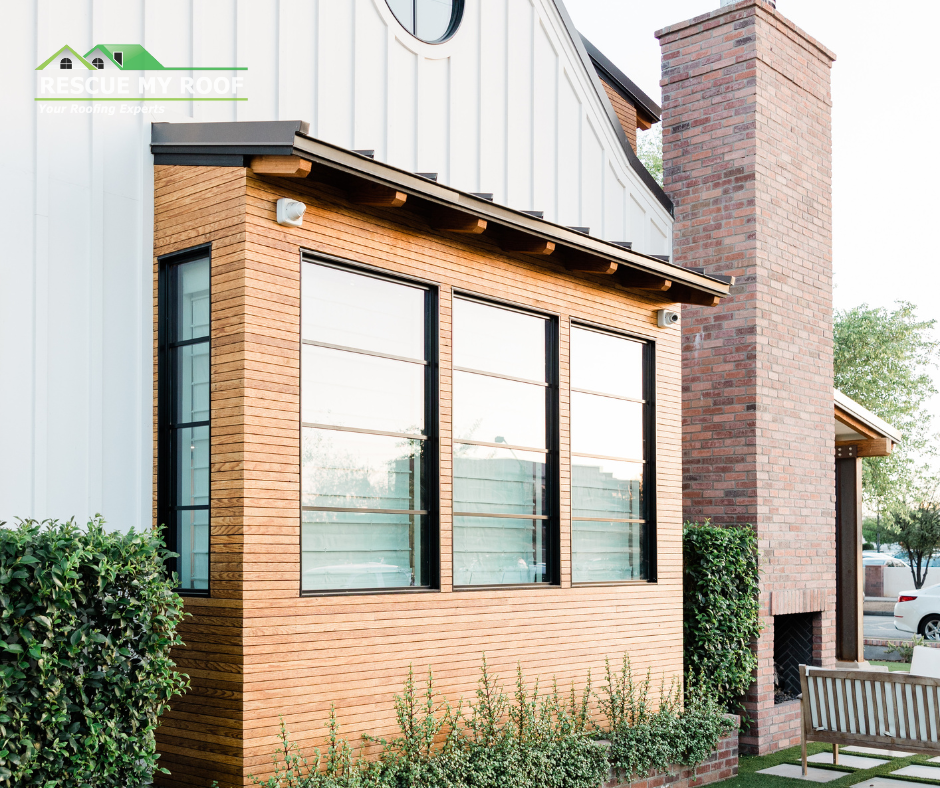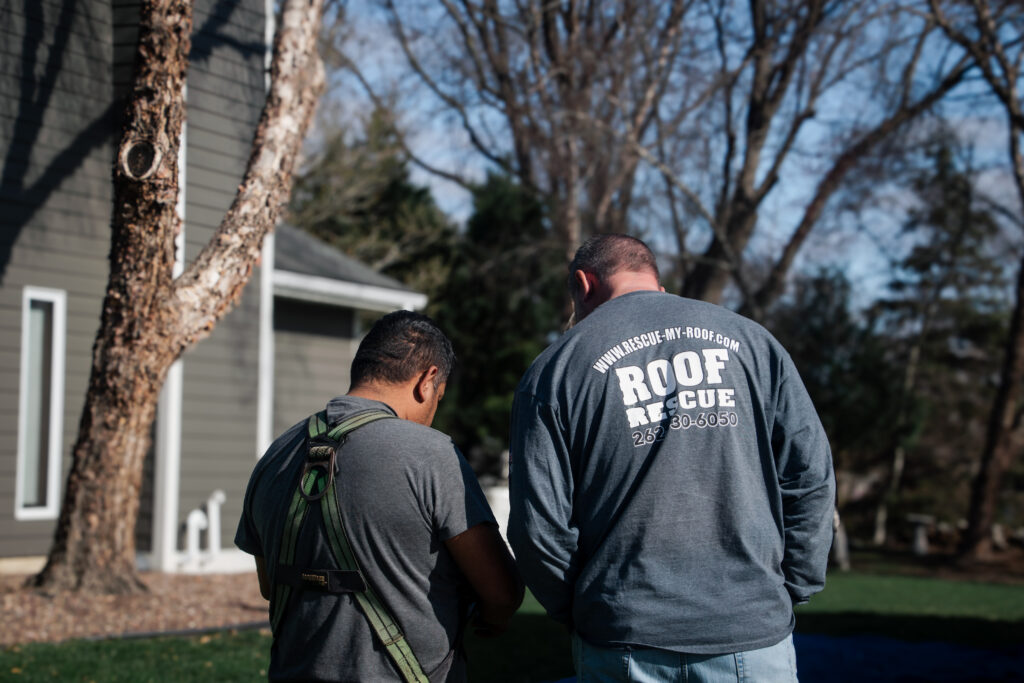7 Things to Know Before Replacing Your Siding (Materials, Pricing & More)
Replacing your home’s siding is a significant investment, but it’s also one that can dramatically improve your home’s curb appeal, energy efficiency, and protection from the elements. Whether you’re upgrading to a more durable material, improving insulation, or simply refreshing the look of your exterior, there are several factors to consider before diving into a siding replacement project.
For over a decade, Rescue My Roof has been a leader in the siding industry. We’ve helped hundreds of homeowners protect their homes. Today, we’re using our expertise to break down the essential things you must know before replacing your siding.
Here’s what homeowners need to know before replacing their siding to make sure they’re prepared and, ultimately, make the best decisions for their home.
The Top 7 Things to Consider Before Replacing Your Siding
A siding replacement is a big financial investment. It’s crucial to be prepared before hiring a contractor and beginning the project.
Before you jump in to a siding replacement, here are seven things you should know.
1. Understand Your Siding Options
There are various types of siding materials available, each with its own advantages and drawbacks. Choosing the right one depends on your budget, climate, and long-term maintenance preferences.
- Vinyl Siding: One of the most popular and affordable options, vinyl siding is low-maintenance and comes in a wide range of colors and styles. However, it’s less durable than some other materials and can crack in extreme weather.
- Fiber Cement Siding: Known for its durability and resistance to fire, insects, and rot, fiber cement siding (like James Hardie) offers the look of wood without the high maintenance. It’s more expensive and heavier than vinyl, making installation more involved.
- Wood Siding: Offers a classic and natural look but requires regular maintenance, including painting or staining, to protect against moisture, rot, and pests.
- Metal Siding: Aluminum or steel siding is durable and resistant to fire, rot, and pests. It’s ideal for modern or industrial-style homes but can be prone to dents and may require repainting over time.
- Brick or Stone Veneer: These materials offer a timeless, high-end appearance and incredible durability. However, they are more expensive and heavy, which may require structural reinforcement.
2. Energy Efficiency
Replacing your siding can also be an opportunity to improve your home’s energy efficiency. Many homeowners add a layer of insulation behind the new siding, which can help reduce heating and cooling costs.
If energy efficiency is a priority for you, consider insulated siding options or adding foam insulation during the installation process.
Things to look for:
- R-Value: This measures the insulation’s ability to resist heat flow. The higher the R-value, the better the insulation. Ask your contractor about the R-value of the siding materials and any additional insulation being installed.
- Energy Star Ratings: Some siding products are Energy Star certified, which means they meet specific criteria for energy efficiency.
3. Think About Durability and Maintenance
Siding is a long-term investment, so it’s crucial to choose a material that will stand up to your local climate and require minimal maintenance over time. For example, homes in humid areas may need siding resistant to moisture and mold, while homes in storm-prone regions should have materials that can withstand strong winds and hail.
Key considerations:
- Weather Resistance: Consider siding that can handle your region’s climate, from harsh winters to humid summers.
- Maintenance Needs: Some siding materials, like wood, require frequent upkeep, such as repainting and resealing, while others, like vinyl or fiber cement, are low-maintenance and only need occasional cleaning.
4. Prepare for the Installation Process
The installation process can take anywhere from a few days to a couple of weeks, depending on the size of your home and the complexity of the job. During this time, your home’s exterior will be exposed to the elements, and there will be noise and disruption around your property.
What to expect:

- Removal of Old Siding: In most cases, the old siding needs to be removed before the new siding is installed. This can expose underlying issues like water damage, mold, or pests, which need to be addressed before the new siding goes up.
- House Wrap or Underlayment: Many contractors will install a moisture barrier or house wrap underneath the new siding to protect your home from water infiltration.
- Weather Delays: Since siding installation is an exterior job, the weather can impact the timeline. Be prepared for potential delays if there’s rain, snow, or high winds.
5. Don’t Forget About Aesthetics

Siding significantly impacts your home’s curb appeal, so take the time to choose a color and style that complements your home’s architecture. Many siding materials come in a variety of colors, textures, and finishes, so you can achieve the look you want, whether it’s a traditional, modern, or rustic style.
Things to consider:
- Color: Lighter colors can help reflect sunlight, which might help keep your home cooler, while darker colors absorb heat. Keep in mind that some materials, like vinyl, are more prone to fading over time.
- Style: Options range from traditional horizontal lap siding to more decorative styles like shake, shingle, or board-and-batten.
- Trim and Accents: Coordinating trim, shutters, and other accent pieces can enhance the overall look of your home. Make sure your siding choice pairs well with these elements.
6. Budget and Financing Options
The cost of replacing siding can vary widely depending on the material you choose, the size of your home, and labor costs in your area. It’s essential to set a budget and get multiple estimates from reputable contractors to ensure you’re getting the best value for your money.
What to include in your budget:
- Material Costs: Siding materials can range from affordable options like vinyl to premium choices like stone veneer.
- Labor Costs: Installation costs can vary depending on the complexity of the job, the condition of your current siding, and the contractor’s rates.
- Potential Repairs: If underlying issues like water damage or mold are discovered during the installation process, you’ll need to budget for repairs.
Financing options:
- Home Equity Loans: Many homeowners use home equity loans or lines of credit to finance large renovation projects like siding replacement.
- Contractor Financing: Some contractors offer financing options or payment plans to make the cost more manageable.
- Tax Credits: In some cases, installing energy-efficient siding can qualify you for tax credits or rebates.
7. Hire a Qualified Contractor

Choosing the right contractor is one of the most critical steps in a successful siding replacement project. A skilled and experienced contractor can ensure that the siding is installed correctly and that any underlying issues, such as water damage or insulation problems, are addressed.
How to find the right contractor:
- Look for experience: Choose a contractor with a proven track record of installing the type of siding you want.
- Check reviews and references: Ask for references from past clients and read online reviews to get a sense of the contractor’s reputation.
- Verify licensing and insurance: Ensure the contractor is licensed and insured to protect yourself from liability in case of accidents or damage during the project.
- Get multiple quotes: Compare quotes from several contractors to make sure you’re getting a fair price for the job.
Preparing for a Successful Siding Replacement
Replacing your siding is a significant investment that can dramatically improve your home’s appearance, energy efficiency, and protection from the elements. Understanding your material options, considering energy efficiency and durability, and hiring a qualified contractor allows you to be well-prepared and make the best decisions for your home.
Take the time to plan, budget, and ask questions throughout the process to ensure a successful siding replacement that enhances the beauty and functionality of your home for years to come.
Learn more with “Siding Maintenance 101: How to Keep Your Home’s Exterior in Top Shape” and “How Long Does Vinyl Siding Last? (Lifespan, Maintenance & More).”
Are you looking for a siding contractor in southeastern Wisconsin? Rescue My Roof has got you covered. Contact us today to get a free siding estimate.


